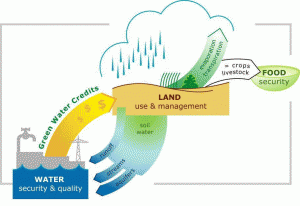Green Water Credits can be seen as an investment mechanism for upstream farmers to practice soil and water management activities that generate benefits for downstream water users, which are currently unrecognized and unrewarded. FutureWater coordinated and carried out the biophysical assessment that quantified the impact of Green Water Credits practices on the green and blue water and sediment fluxes in the Upper Tana basin. The analysis lead to identification of potential target areas for GWC pilot operation on biophysical grounds.
Green Water Credits can be seen as an investment mechanism for upstream farmers to practice soil and water management activities that generate benefits for downstream water users, which are currently unrecognized and unrewarded. This initiative is driven by economic, environmental and social benefits. The implementation of GWC has the potential of enhancing overall water management by reducing damaging runoff, increase groundwater recharge, simulate a more reliable flow regime, and reduce harmful sedimentation of reservoirs.

Green Water Credits: the concept.
FutureWater coordinated and carried out the biophysical assessment that quantifies the impact of Green Water Credits practices on the green and blue water and sediment fluxes in the Upper Tana basin. The analysis leads to identification of potential target areas for GWC pilot operation on biophysical grounds. This required a distributed modeling approach (SWAT) accounting for the heterogeneities in the basin in terms of precipitation regime, topography, soil characteristics and land use. The developed tool quantifies the benefits of the management practices on erosion reduction and green and blue water flows in the basin.
Links
- Green Water Credits site
- ISRIC World Soil Information
- IFAD International Fund for Agricultural Development
Related publications
2019 - Ecosystem Services
Aggregate effects on ecosystem services from certification of tea farming in the Upper Tana River basin, Kenya
Willemen, L., N.D. Crossman, D. Newsom, D. Hughell, J.E. Hunink, J.C. Milder
2012 - Journal of Environmental Management
Quantitative simulation tools to analyze up- and downstream interactions of soil and water conservation measures: Supporting policy making in the Green Water Credits program of Kenya
Hunink, J.E., P. Droogers, S. Kauffman, B.M. Mwaniki, J. Bouma
2009 - FutureWater Report 84
Green Water Credits for the Upper Tana Basin, Kenya. Phase II – Pilot Operations: Biophysical assessment using SWAT
Hunink, J.E., W.W. Immerzeel, P. Droogers
2007 - Green Water Credits Report 4
Quantifying water usage and demand in the Tana River basin: an analysis using the Water and Evaluation Planning Tool (WEAP)
Hoff, H., S. Noel, P. Droogers
2006 - FutureWater Report 54
Green and blue water services in Tana river basin, Kenya, exploring options using an intergrated modeling framework
Droogers, P., J.H. Kauffman, W.W. Immerzeel
2006 - ISRIC report 2006/04
Green Water Credits: Basin identification
Droogers, P., J.H. Kauffman, J.A. Dijkshoorn, W.W. Immerzeel, J.R.M. Huting
2006 - FutureWater Report 53
River basin models to support Green Water Credit Assessment
Droogers, P., S. Mantel, J.H. Kauffman

